Webinar Recap: Making Virtual Learning a Success with Simulations
By Admin
How can you create engaging, impactful learning experiences while teaching online?
That was the question we recently tackled in our webinar: Making Virtual Learning a Success with Simulations, with Professor Carsten Bartsch, from the University of the Bayern Economy (HDBW). As many other instructors across the globe, Professor Bartsch was confronted with having to move his face-to-face courses completely online last year, as international lockdowns took place. But he managed to make his online classroom experience successful with the Markstrat business simulation. One year later, online teaching is still very much the norm and will most likely remain one of the main ways students will learn in the years to come.
Read on to find out the key learning points from the webinar and concrete tips on how to successfully implement a business simulation in the online classroom for maximum engagement.
The challenges of the virtual classroom
We started the webinar by polling the 77 participants, asking them what the most challenging thing about teaching in the virtual classroom was.
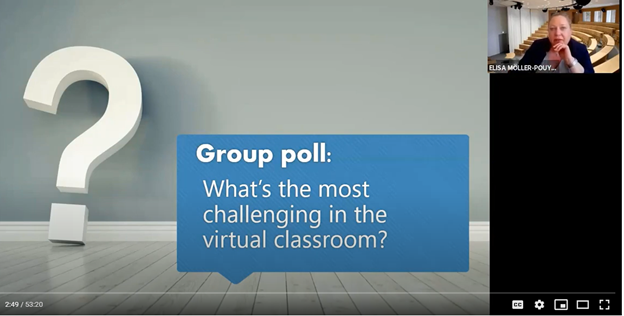
- 60% believed engagement to be the most challenging thing to achieve when teaching online
- 20% thought the lack of non-verbal cues makes online teaching the most difficult
- 11% were convinced that interactions between learners tends to be the hardest in the virtual classroom.
- 9% thought that tracking student progress was the most difficult element to virtual teaching.
A recent LinkedIn survey we conducted with our instructors found similar results, concluding that while many elements can create barriers to an effective online learning process, lack of engagement is the top concern for educators.
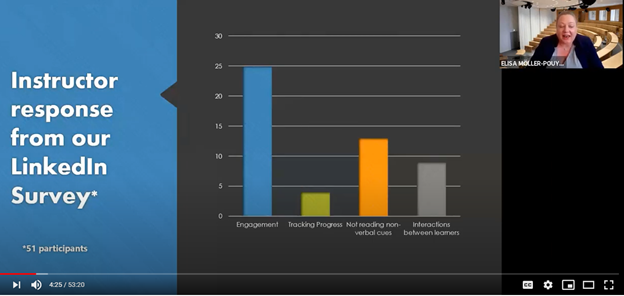
Creating an equal learning experience
Carsten, a long time Markstrat simulation user, shared his own personal challenges that he faced when he had to move his course online. One of the most effective elements of using a business simulation like Markstrat is how it gets teams to interact. So how do you ensure students are interacting with each-other and maintain an engaging level of competition when they are doing all of this virtually? How can they effectively learn from each other and share their experiences in a virtual environment? His goal was to create an equivalent learning experience to that of the normal classroom.
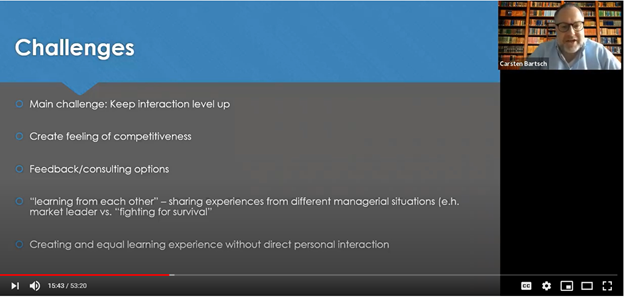
Using a simulation online for engagement
Carsten then got into the details of how he successfully ran Markstrat online for his marketing students. He took advantage of the many features that Zoom allows, such individual breakout rooms and raising hands to keep engagement levels up and to replicate a normal classroom setting. He also established some initial ground rules, such as requiring cameras on.
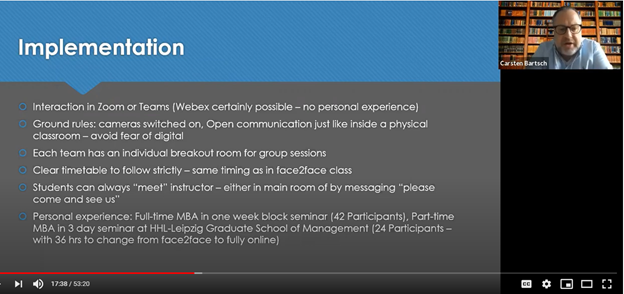
Initial outcomes
After a very short initial hesitation, students happily adopted using the simulation in a virtual setting. Carsten even shared a comment he got from one of his students: “After 2 hours, I did not feel like I was in a digital class anymore.” Additionally, when he compared evaluations from face-to-face courses and the virtual ones using Markstrat, he discovered that students gave both the same marks. Ultimately, he concluded, that running Markstrat online was effective and led to learning outcomes and satisfaction that rivaled that of a traditional setting.
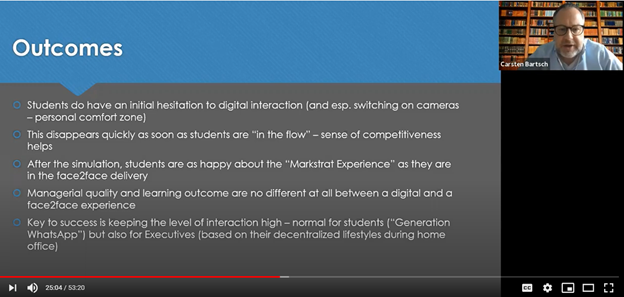
Tips for making online learning successful
The first thing Carsten insisted on was to not “change too much!”. He explained that an online environment is not so different from a face-to-face one, and the more you replicate experiences to those in a face-to-face setting, the better. He suggests a warmup exercise like a case study that prepares participants for a typical challenge in Markstrat, such as cases that focus on customer segmentation, understanding the competition and so forth. This pushes students to discuss and sets the tone for the simulation. Another tip Carsten shared was to have the instructor act as a consultant and to pop into breakrooms to advise and discuss strategy throughout the game. He also suggests teams to present to a virtual boardroom at the end to discuss lessons learned and to have a Q&A from other teams.
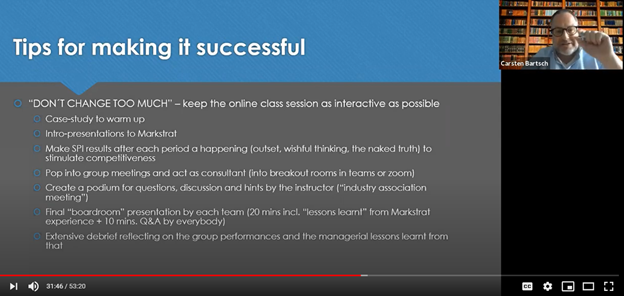
Conclusion
If there was one thing to gather from Carsten’s experience and feedback, it was that using a business simulation such as Markstrat online, is an extremely effective way to engage learners. If done correctly, your virtual classroom experience can rival that of a traditional one.
We would like to thank Carsten for sharing his valuable knowledge on this subject.

%20(LinkedIn%20Sponsored%20Content)%20(95)-min.png?width=800&name=Green%20and%20Black%20Live%20Podcast%20Guesting%20Instagram%20Post%20(600%20%C3%97%20250%20px)%20(LinkedIn%20Sponsored%20Content)%20(95)-min.png)
%20(LinkedIn%20Sponsored%20Content)%20(99)-min.png?width=352&name=Green%20and%20Black%20Live%20Podcast%20Guesting%20Instagram%20Post%20(600%20%C3%97%20250%20px)%20(LinkedIn%20Sponsored%20Content)%20(99)-min.png)
%20(LinkedIn%20Sponsored%20Content)%20-%202022-07-06T144952.090-min.png?width=352&name=Green%20and%20Black%20Live%20Podcast%20Guesting%20Instagram%20Post%20(600%20%C3%97%20250%20px)%20(LinkedIn%20Sponsored%20Content)%20-%202022-07-06T144952.090-min.png)
%20(LinkedIn%20Sponsored%20Content)%20(97)-min.png?width=352&name=Green%20and%20Black%20Live%20Podcast%20Guesting%20Instagram%20Post%20(600%20%C3%97%20250%20px)%20(LinkedIn%20Sponsored%20Content)%20(97)-min.png)